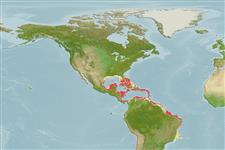Environment: milieu / climate zone / depth range / distribution range
Ecología
marino asociado a arrecife; rango de profundidad 1 - 73 m (Ref. 7365). Subtropical; 30°N -
Western Atlantic: Florida (USA), Bahamas, and Yucatan (Mexico) to Curaçao and probably northern South America.
Tamaño / Peso / Age
Maturity: Lm ? range ? - ? cm
Max length : 11.0 cm SL macho / no sexado; (Ref. 26938)
Short description
Morfología | Morfometría
Espinas dorsales (total): 12; Radios blandos dorsales (total): 8-9; Espinas anales 3; Radios blandos anales: 5. No occipital pit; two spines on part of preorbital overlapping maxillary; no supplemental preopercular spine; mushroom-like tabs on upper part of cornea present (Ref. 13608).
Inhabits primarily offshore islands and infrequently caught in continental waters (Ref. 5521). Also found in clear water over sand and turtle grass; less common around coral reefs (Ref. 26938).
Life cycle and mating behavior
Madurez | Reproducción | Puesta | Huevos | Fecundidad | Larva
Robins, C.R. and G.C. Ray, 1986. A field guide to Atlantic coast fishes of North America. Houghton Mifflin Company, Boston, U.S.A. 354 p. (Ref. 7251)
IUCN Red List Status (Ref. 130435)
Threat to humans
Harmless
Human uses
Más información
Age/SizeCrecimientoLength-weightLength-lengthLength-frequenciesMorfometríaMorfologíaLarvaDinámica larvariaReclutamientoAbundanciaBRUVS
ReferenciasAcuiculturaPerfil de acuiculturaRazasGenéticaElectrophoresesheritabilidadEnfermedadesProcesamientoNutrientsMass conversion
ColaboradoresImágenesStamps, Coins Misc.SonidosCiguateraVelocidadTipo de nataciónSuperficie branquialOtolitosCerebrosVisión
Herramientas
Special reports
Download XML
Fuentes de Internet
Estimates based on models
Preferred temperature (Ref.
123201): 25.2 - 28, mean 27.1 °C (based on 260 cells).
Phylogenetic diversity index (Ref.
82804): PD
50 = 0.5000 [Uniqueness, from 0.5 = low to 2.0 = high].
Bayesian length-weight: a=0.01318 (0.00626 - 0.02776), b=3.03 (2.86 - 3.20), in cm total length, based on LWR estimates for this Genus-body shape (Ref.
93245).
Nivel trófico (Ref.
69278): 3.7 ±0.5 se; based on diet studies.
Resiliencia (Ref.
120179): Alto, población duplicada en un tiempo mínimo inferior a 15 meses (Preliminary K or Fecundity.).
Fishing Vulnerability (Ref.
59153): Low vulnerability (10 of 100).
Nutrients (Ref.
124155): Calcium = 60.9 [23.6, 182.7] mg/100g; Iron = 0.72 [0.35, 1.81] mg/100g; Protein = 19.1 [17.4, 20.8] %; Omega3 = 0.399 [0.164, 1.137] g/100g; Selenium = 12 [5, 31] μg/100g; VitaminA = 118 [36, 402] μg/100g; Zinc = 1.11 [0.68, 1.75] mg/100g (wet weight);
